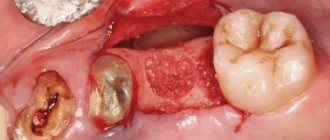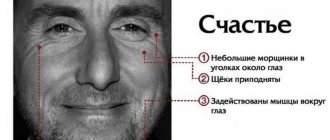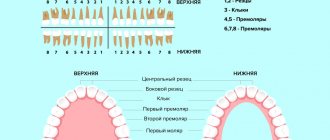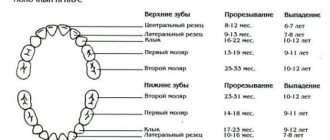Many people have heard about such an operation as cutting the frenulum under the tongue in children, but not everyone understands why and when it is necessary. The problem with the imperfect structure of the hyoid frenulum can appear at different ages
, and parents really need to pay due attention to this. Despite the fact that this part of the body seems very insignificant, it is associated with the process of eating and speech production. Its anomaly can indirectly affect vital phenomena in the body.
The essence of the problem
Photo: this is what a normal frenulum looks like in a child’s mouth
The tongue is attached to the base of the mouth by its root part. Between the tongue and the lower edge of the mouth there is a small fold of skin - the frenulum. Normally, it should be such a length that a person can easily move his tongue, stick it slightly beyond the lips, touch the front surface of the teeth, and pronounce sounds.
A shortened frenulum of the tongue greatly limits its mobility, speech capabilities and ability to eat normally.
, especially in children. The same problems arise if it is not attached correctly, when it is in close proximity to the tip of the tongue.
The consequences are:
- Photo: this is what an incorrectly positioned frenulum looks like
During the period of breastfeeding, the baby is unable to suckle normally, as the tongue is limited in its movements. Because of this, children become very anxious, cry, and lose weight.
- Lack of nutrition can have a negative impact on any developing system of the body, causing stomach diseases.
- A child with a short frenulum develops an incorrect bite, which causes dental diseases and their displacement.
- After teething, when trying to stick out the tip of the tongue, the baby will injure it on the lower incisors.
- In older children, a short hyoid frenulum complicates the formation of sounds: it is difficult for them to pronounce words, and the process of learning speech is delayed.
- The breathing mechanism changes: the baby gets used to breathing through the mouth. Symptoms of the pathology
The frenulum in newborns normally has a length of about 8 mm
or more, and for five-year-old children it increases to 17. But mothers are not always able to take measurements at home, especially if the baby is very active. And only specialists can understand whether everything is located correctly in the oral cavity.
You can determine whether a child has a short frenulum by some external signs:
- In infants, due to their low ability to suck milk, loud smacking and clicking sounds appear.
- The baby attaches incorrectly to the breast, does not cover the areola with his mouth, so he often bites the nipple, which then becomes inflamed.
- The baby is nervous, arches, twists his arms and legs when feeding, often throws and applies to the breast again. Does not gain weight or even lose it.
- The tip of the tongue may be bifurcated due to shortening of the septum. What a child’s forked tongue looks like with a short frenulum, look at the photo on the right.
- Older children have noticeable speech defects, their voice is nasal and quiet.
- Saliva production increases.
- Apnea attacks are possible.
- Due to insufficient food processing, digestive problems occur.
If parents suspect a problem, they should contact their pediatrician or dentist. But in many cases, the defect is determined by a neonatologist in the maternity hospital.
Plastic surgery of the frenulum is carried out in several stages:
- frenotomy – the frenulum of the upper lip is dissected;
- frenectomy – excision of the frenulum of the upper lip is performed;
- frenuloplasty – the place where the frenulum is woven is moved to a new depth.
The operation is performed using two methods. Its classic version uses a scalpel. A more modern method is laser surgery. However, despite all the advantages of laser correction, the classical method remains relevant, which is used in our clinic. This is especially true for complex clinical cases, in which the skill of the surgeon is very important. Upper lip plastic surgery is performed on an outpatient basis. The duration of the classic operation is no more than a quarter of an hour, and local anesthesia (injections or gel) is used.
If you retract the lip with a narrow frenulum of the upper lip, it is possible to see a transparent film that is not attached to the edge of the alveolar process. It is cut transversely, then longitudinal sutures are applied.
In the case of a wide frenulum of the upper lip, the doctor makes an incision in the tense frenulum along the ridge, excises the interdental papilla and the tissues of the bone space located between the roots of the central incisors.
Causes of the defect
A short frenulum of the tongue in a newborn is a congenital anomaly
, which is formed in the first months of fetal development, when all organs are formed. There are several reasons for its appearance:
- The presence of a hereditary predisposition: if the parents had such a feature, it can be inherited.
- The older the expectant mother, the more likely her child is to develop a short frenulum due to the increased risk of developing anomalies.
- The defect can develop if a woman has an infection during pregnancy or suffers from chronic diseases.
- Severe early toxicosis can lead to a lack of nutrients, which is why the fetal organs do not form correctly.
- Exposure to any teratogenic factors: radiation, toxic substances, drugs that are harmful to the body, alcohol, tobacco and drugs.
- Accidents involving injuries to pregnant women.
Some of these reasons do not depend on the actions of future parents, especially genetic predisposition. Other risk factors should be avoided: a pregnant woman should not work in hazardous work, drink, smoke, self-medicate, or expose herself to the risk of falls when playing sports.
Ways to solve the problem
At the moment, there are several correction methods:
- Trimming the frenulum in children with a scalpel.
- Laser cutting of the frenulum under the tongue.
- Stretching through exercise.
- Removing the defect using massage.
Surgical interventions can be performed in different ways, the main methods are:
- Frenuloplasty is the removal of a flap from the tissue of a defective bridge, which is sutured to the resulting wound to increase the mobility of the tongue. Local anesthesia is required, but the damaged mucous membrane heals very quickly. Used for preschool children.
- Frenulotomy: the length of the frenulum is conventionally divided into three parts, an incision is made between the lower and middle lobes, and the edges of the mucous membrane are sutured. This method is suitable for infants.
- Frenulectomy is the same manipulation, but the frenulum is clamped with instruments. The method is suitable for five-year-old children.
In more modern clinics, trimming is performed using a laser. The dissection is carried out after treatment with an anesthetic: gel, spray. For patients, such cutting is less traumatic, damage to blood vessels is minimal - the laser simultaneously cuts the mucous membrane and causes adhesions of the affected capillaries
.
Tissue regeneration after laser trimming takes place within a few days, and you can return to your normal lifestyle an hour after the procedure. But how long you need to stay in the clinic is decided by the doctor. Complications are less common than after eliminating the defect with a scalpel.
How to correct a short frenulum of the tongue?
Let's consider a surgical method to solve the problem. How to correct a short frenulum of the tongue? There is a scalpel method and laser surgery. The first involves mechanical incision (in one of several options) and suturing of the ligament if necessary. All this takes place under local anesthesia. The operation takes on average 30 minutes.
Frenumplasty can be performed in different ways. It is possible to make incisions to the ligament followed by sutures in the lower and upper parts, incisions on the sides, as well as moving the attachment site of the ligament.
The recovery period lasts about a week. At this time, swelling and slight pain may occur. After 10 days, the stitches will begin to dissolve. During recovery, care must be taken when eating, and the baby's parents should monitor this. In addition, the dentist may recommend rinsing the mouth with a special solution or using healing medications.
Optimal age for surgery
Is it worthwhile to manipulate the frenulum under the tongue and at what age is it better to trim it? Such decisions depend on when the anomaly was discovered and what the individual characteristics are. If in the maternity hospital the neonatologist determines that the baby has a defective hyoid frenulum, it is better to trim it immediately.
The baby is not yet so mobile as to interfere with the procedure, and the membrane itself is small, thin and does not contain blood vessels. Thanks to these factors, local anesthesia will be sufficient for the manipulations, and you can calm the baby by applying it to the chest after the operation.
Trimming the frenulum of the tongue in children over 6 months of age is associated with some difficulties. The baby becomes mobile, and parents cannot discipline him with persuasion. Due to careless movements, surgery may not occur correctly, which is why surgery is postponed until the age of five
.
During this period, children talk, the doctor can determine whether there are speech defects, whether the frenulum under the tongue is bothering the child, whether it needs to be trimmed or whether it can be stretched with gymnastics.
If the infant’s tongue frenulum was not cut, and many years later he developed speech defects, breathing and digestive problems, then it needs to be circumcised in adulthood. But the older a person is, the denser his membrane becomes, it becomes overgrown with capillaries and nerve endings - which is why cutting it is much more painful than in the case of a baby. Anesthesia is required to make the incision.
Treatment
To correct frenulum pathology, techniques such as frenulotomy, frenectomy, and frenuloplasty are used.
In the standard version of lingual frenuloplasty, a submucosal flap is formed and the attachment site of the lingual frenulum is transferred. Several self-absorbing sutures are applied. During the operation, control over the mouths of the ducts of the sublingual and submandibular salivary glands is necessary to avoid damage during incision and suturing. Traumatization of the excretory ducts of the salivary glands can lead to disruption of the outflow of saliva.
Laser surgical treatment, unlike traditional ones, has bacteriological and bacteriostatic effects, is characterized by the absence of postoperative bleeding, accuracy, does not require sutures, provides rapid recovery, reduced pain response and rapid wound healing compared to traditional methods. Laser surgery is usually performed under local anesthesia. The method allows the use of anesthetic drugs in lower dosages. The duration of the operation itself is 4-6 minutes. There is no need for suture material. A bandage with drugs that accelerate healing is applied to the wound.
Optimal age for surgery
Plastic surgery is most often performed in children, but is also prescribed for adult patients.
If a short frenulum interferes with normal breastfeeding, then surgery should be performed as early as possible. It can be dissected immediately after birth. There are no age restrictions for adults. The operation is performed if there is a risk of periodontal diseases.
It is best to perform plastic surgery on children before entering school.
Examinations before surgery and contraindications
Any surgical procedure in the oral cavity is a risk to the body. In order to prevent complications after surgery, it is necessary to undergo preliminary examinations prescribed by the doctor. The most significant tests are blood and urine tests, determination of blood coagulation and fluorography.
Contraindications for frenuloplasty are infections of the throat, oral cavity, inflammatory processes in any part of the body
, since pathogenic microorganisms can enter the incision of the mucous membrane. This is why a mandatory examination is carried out before intervention. You cannot operate on patients with cancer or decreased blood clotting.
Postoperative period
The mucous membrane in the mouth is restored quickly. But cutting the frenulum can cause complications:
- Formation of a hard scar at the site where the incision was made.
- The development of the inflammatory process due to infection.
- Temperature increase. It appears as a sign of the development of an infectious process or a peculiar reaction to an operation.
The baby may react to complications with constant anxiety and refusal to eat. Children three years old and older can tell themselves what worries them. If you experience any discomfort, you should consult a doctor; only a specialist will correctly assess the baby’s condition and prescribe the best treatment.
To avoid complications, you need to keep your mouth clean. Five-year-old children already brush their teeth and can rinse their mouths with water. For several days after the defect is removed, you should not chew solid food or talk much.
You should ask your doctor exactly how long the restrictions should be observed. After a follow-up examination, the attending doctor will recommend special exercises to develop the elasticity of the frenulum.
Correction using gymnastics for the tongue
Only a doctor can determine whether it is worth performing surgery on a child’s short frenulum of the tongue or whether it is better to remove the defect with the help of exercises. Therefore, even if parents are not inclined to undergo surgery, they still need to go to a pediatrician or dentist for consultation and surgery or correct individual selection of exercises.
The opportunity to conduct gymnastic classes appears when the baby can already repeat some given actions. But there are simple exercises even for newborns: they are given a silver spoon to lick, milk is dripped onto their upper lip, which makes them try to lick it, and at a slightly older age they are smeared with jam.
When the baby is able to understand the mother’s requests to repeat certain actions, you can do more complex gymnastics:
- Close your mouth and feel the side walls of your tongue, palate and lower part of your mouth.
- Open your mouth and reach as far as possible to the outer surface of your lips.
- Click your tongue.
- Place the tongue on your lower lip and hold it in this position for 10 seconds.
- Stick your tongue out as far as possible and hold for 10 seconds. You can also ask the baby in a playful way to show how long his tongue is.
What types of malocclusions can occur?
Gaps between teeth are not a pathology, since baby teeth are smaller than molars and are often “free” in the jaw. But if the second or third upper tooth is located too high, above the dentition, this may indicate that the teeth tend to erupt incorrectly.
If some teeth have not erupted at all by the required age, it is also worth paying attention to this. Perhaps now they do not have enough space or the matter is in the general state of the child’s health.
You can also notice improper closure: if the lower jaw is pushed forward or, conversely, is not sufficiently developed, or if the dentition is crossed and closed asymmetrically. There is always a reason for such violations. If it is not detected, the correct treatment cannot be prepared.
But now the diagnosis has been made, and the child is too small to wear any structures. Is it possible to help him?
Orthodontists unanimously answer this question: yes, it is possible to correct violations in time so that the permanent bite is formed correctly.
Torn frenulum
In some children, an unfortunate fall causes a rupture of the frenulum of the tongue. This injury can occur due to close contact of the septum with the lower teeth.
. If a child cuts the frenulum, he may experience bleeding and swelling in the oral cavity, and it becomes painful for the baby to chew and talk.
You cannot rely on self-medication; you should immediately consult a doctor. Sometimes it is necessary to stitch up the resulting wound due to the risk of excessive bleeding.
The importance of such a part of the body as the frenulum cannot be underestimated. There are many ways to lengthen the small septum to free up the tongue for free speech and eating. Before taking certain measures, it is necessary to consult with a specialist and do preoperative tests if it is necessary to trim the frenulum.
If the anomaly causes organ dysfunction, then frenuloplasty is necessary, and it is best to perform it at the age recommended by the doctor. Ignoring such a problem means exposing the child to the risk of frequent respiratory and digestive diseases, and problems in pronunciation of sounds.










